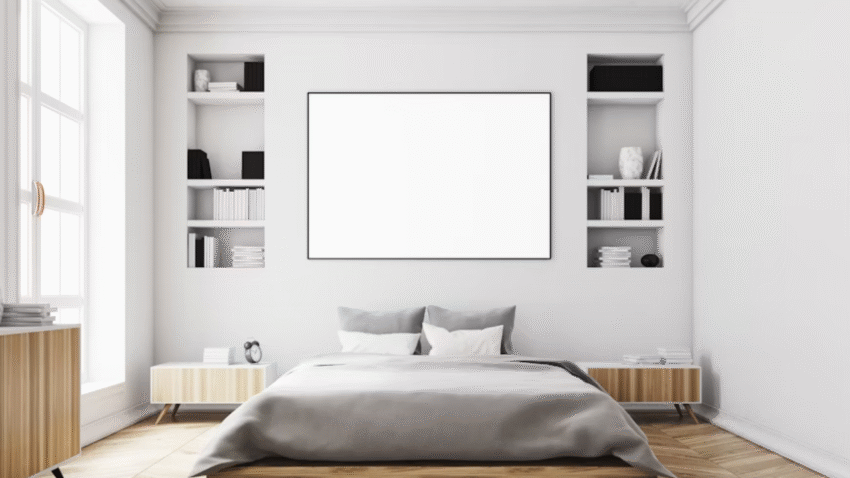Introduction
Do you feel cramped every time you walk into your bedroom? Or maybe your bed blocks natural light or makes it hard to open your dresser drawers? Learning how to arrange bedroom furniture for better flow can completely transform how your space feels and functions. Good furniture placement maximizes your square footage, improves air circulation, and creates a sense of calm that makes falling asleep—and waking up—so much easier.
Why Furniture Flow Matters in the Bedroom
A bedroom isn’t just for sleeping—it’s your personal retreat, a place to relax, read, get dressed, and recharge. When furniture is poorly placed, the space can feel cluttered, chaotic, and even stressful. But when you arrange furniture thoughtfully, you create clear pathways, highlight natural light, and support good sleep hygiene. Better flow makes your bedroom feel larger, more peaceful, and easier to keep tidy. Plus, a well-laid-out bedroom just looks better!
Step-by-Step Guide to Arrange Bedroom Furniture for Better Flow
1. Measure Your Bedroom
Start with the basics: measure your room, including windows, doors, closets, and any architectural quirks like slanted ceilings. Note how the door swings open so you don’t block it. Write down your furniture dimensions too—bed, dressers, nightstands, or chairs—so you can plan what fits where.
2. Pick a Focal Point
Most bedrooms revolve around the bed—it’s the star of the show! Decide where you want the bed to go first. Ideally, place it on the longest uninterrupted wall. If you have windows, try centering the bed between them for balance. Avoid blocking windows entirely, so you still get plenty of natural light and airflow.
3. Place the Bed for Good Flow
Your bed placement sets the tone for the whole room.
- Leave at least 24–36 inches of space on either side so you can get in and out easily.
- Make sure there’s enough room to open drawers on your nightstands and dresser.
- If possible, position your bed so you can see the door while lying down. This “command position” is popular in Feng Shui because it feels safe and restful.
4. Arrange Nightstands Within Arm’s Reach
Your nightstands should be within easy reach for lamps, books, or your phone. They should be level with the top of your mattress or just a few inches higher—this keeps the look balanced and practical. If you’re tight on space, try wall-mounted shelves or small side tables instead.
5. Position Dressers and Storage Smartly
Dressers, wardrobes, and chests of drawers are usually the next largest pieces. Place them where drawers can open fully without blocking pathways.
- In small bedrooms, put a dresser opposite or next to the bed for easy access.
- If you have a TV on top of the dresser, make sure it’s directly in view from the bed.
- Use corner spaces for tall dressers or wardrobes to maximize awkward areas.
6. Create Clear Pathways
This is where real “flow” happens! Make sure you have a clear walkway from the bedroom door to your bed. Avoid placing furniture so close together that you have to shuffle sideways to get around. A good rule of thumb is to leave at least 2–3 feet of walking space where you need to move freely.
7. Use Rugs to Define Zones
A well-placed rug anchors the furniture and helps define different zones, especially in larger bedrooms. Place a rug under the bottom two-thirds of the bed, extending past the sides and foot of the bed to create a cozy, balanced look. If you have a chair or reading nook, a smaller rug can visually separate that space too.
8. Consider Seating and Extras
If you have room, add a bench at the foot of the bed or a comfy chair in a corner for reading or putting on shoes. Just make sure extra pieces don’t block natural walkways or make the room feel crowded. If space is tight, skip the extras—better flow is always the priority.
9. Maximize Vertical Space
Good flow isn’t just about the floor—it’s about the whole room. Use wall-mounted shelves, tall bookcases, or hooks to keep items off the floor and clear pathways. Floating furniture like wall-mounted nightstands can also make small bedrooms feel more open.
Common Mistakes to Avoid
Mistake 1: Blocking windows with large furniture.
Solution: Arrange pieces to let in maximum natural light—natural light makes small rooms feel bigger.
Mistake 2: Overfilling the room with furniture you don’t need.
Solution: Keep only what’s functional. Less furniture means more flow.
Mistake 3: Putting the bed right up against a side wall.
Solution: Leave space on both sides so the room feels balanced and you can make the bed easily.
Mistake 4: Forgetting to measure before you move things around.
Solution: Always measure first—your back will thank you!
Mistake 5: Not considering door swing and drawer clearance.
Solution: Make sure doors, drawers, and closets can open fully without hitting other furniture.
Extra Tips & Bedroom Hacks
- Use Mirrors: Placing a mirror opposite a window reflects light and makes the room feel more open.
- Go for Multi-Use Pieces: A storage bench or ottoman adds seating and hidden storage without cluttering the space.
- Check Out This Related Guide: Need more help optimizing your bedroom? Read How to Decorate a Small Bedroom Without Making It Look Crowded for more smart layout ideas.
Conclusion
Learning how to arrange bedroom furniture for better flow turns a cramped, awkward room into a calming, functional retreat. Start with measurements, place your bed thoughtfully, and create clear pathways to make your space feel open and easy to navigate. With these simple tips, your bedroom will feel bigger, brighter, and more restful—exactly what every sleep sanctuary should be. Bookmark this guide so you can come back to it any time your furniture needs a fresh, flow-friendly reset!
